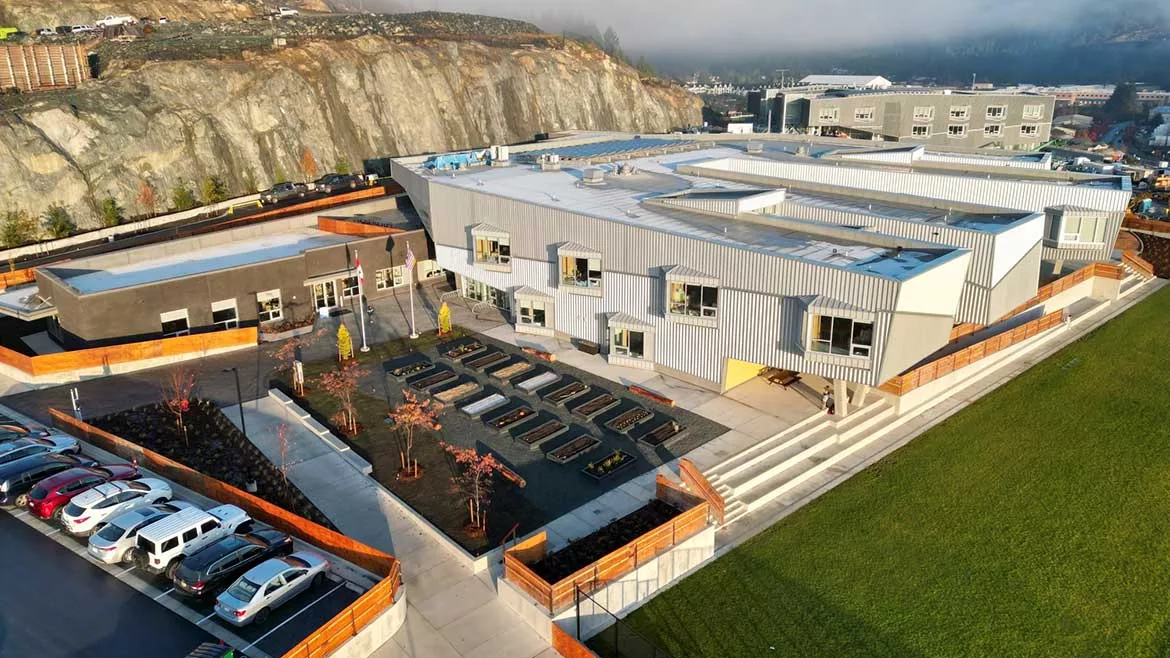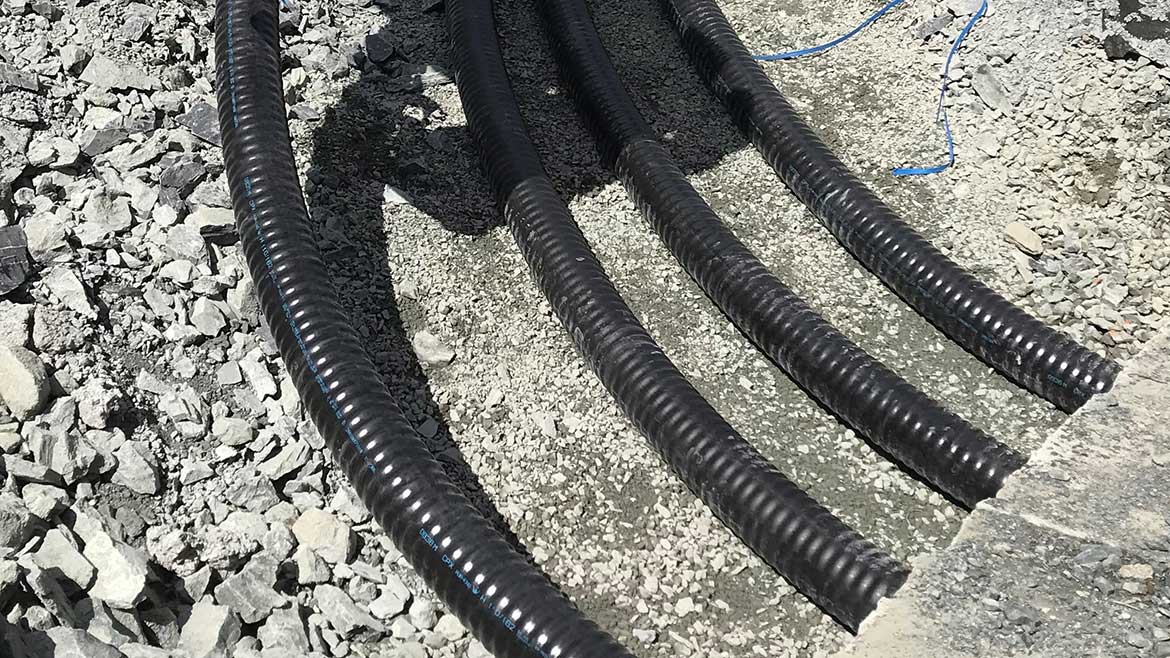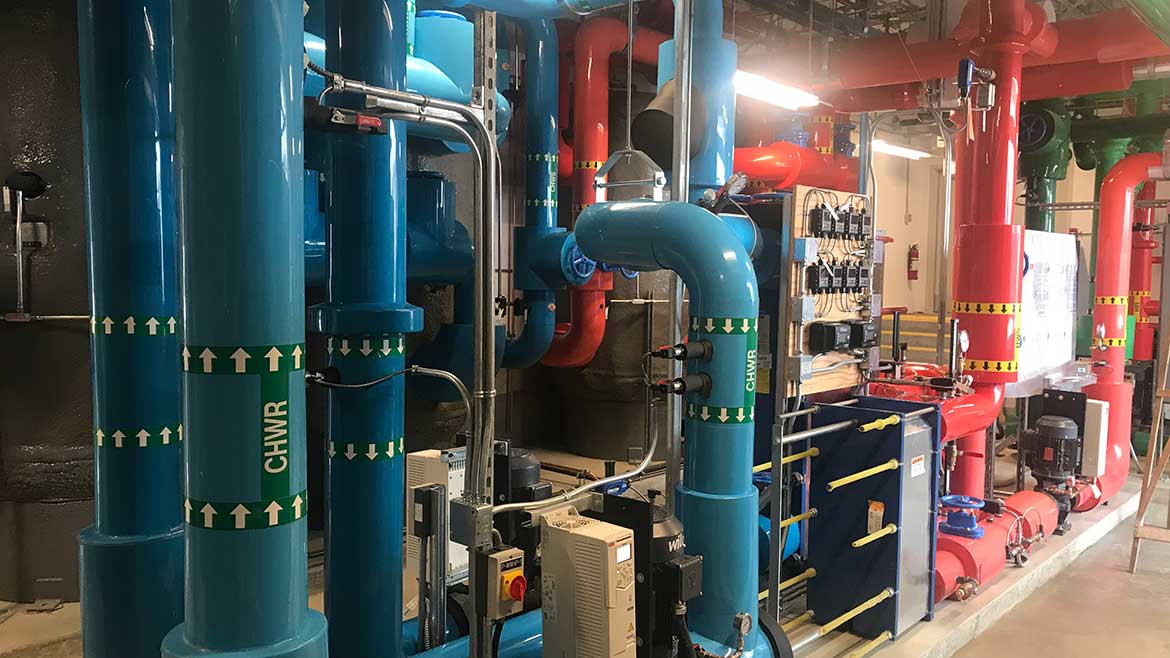Case Study
New school meets energy efficiency needs with pre-insulated PEXa pipe
High-performing district heating application facilitates a high-quality experience for students and teachers.

As more families move to Greater Victoria, the local Sooke School District built two schools for 1,200 elementary and middle school students. Remaining earth-friendly was a key goal, leading the project planners to target LEED v4 Gold certification. The planners designed a district heating application with 2,800 feet of REHAU INSULPEX pre-insulated PEXa pipe to optimize efficiency and provide comfort to teachers and students. | All photos courtesy of REHAU
With many young families moving to the western communities of Greater Victoria, the local Sooke School District found themselves with a need to quickly build more schools for some 1,200 elementary- and middle-school-age students.
Seeking community input for the projects at every juncture, the district would ultimately name the new schools PEXSISEN Elementary — meaning “the opening of hands,” as named by the Songhees First Nation, and Centre Mountain Lellum Middle School — meaning “house” and “the idea of community, where we raise our children” as named by the Beecher Bay Nation.
In addition to fitting into the culture of an inclusive and respectful community, it was also important for the new schools to be seamlessly integrated into the existing landscape and be earth-friendly in every way. This included optimizing energy efficiency by targeting LEED v4 Gold certification. To achieve this goal, the project incorporated elements such as photovoltaic panels on the roof, strategically positioned and designed windows and a geothermally-boosted HVAC system that runs heating and cooling water through the ground to extract or reject heat as needed for added efficiency.

With ambitious energy targets in place, the project planners for the Vancouver Island Schools specified REHAU INSULPEX to efficiently transfer hot and chilled fluid from the central plant to the schools for heating and cooling. Maintaining temperatures in energy transfer piping applications tends to be a challenge, but INSULPEX allowed the engineers to minimize energy loss and deliver favorable performance results.
Of significant note in this regard, the planners also decided upon a district heating model, in which a central plant collects and distributes energy between the two schools for flexible heating and cooling. Rather than having two mechanical rooms, water is conditioned at a single heating/cooling plant to easily accommodate different energy cycles between the schools. If one building requires less heat, the excess heat can be moved to the other building. Heating and cooling can be produced simultaneously by the water source heat pump, with additional heating provided by electric boilers as needed. The water is then delivered through underground piping to the terminal units of each school, where it is used by local HVAC systems to provide comfortable heating and cooling.
According to Michael Hladky, principal of engineering firm SMcN Consulting, the key in these distribution piping or energy transfer piping applications is to keep the heating or cooling energy from escaping while it travels to the schools, maintaining temperatures. To meet the challenge, the team specified REHAU INSULPEX pre-insulated PEXa pipe as the basis of design. INSULPEX pipe is specially designed to efficiently transfer hot or chilled fluid through buried pipelines, minimizing energy loss.
Transferring energy from the central plant to each school is 125 mm INSULPEX pipe. The middle school uses2,200 feet of INSULPEX, while the elementary school uses 600 feet. In both cases, the flexible pipe is supplied in coil lengths of 130 feet or greater and consists of PEXa O2 barrier pipe surrounded by foam insulation and a durable corrugated PE outer jacket. REHAU O2 barrier pipe has a co-extruded oxygen diffusion layer that prevents corrosion of any cast iron components within the heating system in compliance with DIN 4726.
High-quality specialized pipe backed by outstanding service
The project team reports several aspects of the product and REHAU’s supporting service that impressed them during the build — starting right up front. For example, notes Hladky, the engineering team needed to do a lot of number-crunching and run many “what-if” scenarios to determine the optimal sizing and other specifications for the project. This can be time-consuming, but, says Hladky, REHAU’s willingness to provide information made the process easier and surer than expected.

REHAU INSULPEX helped the project engineers meet demanding design criteria, while also streamlining the installation for contractors. Unlike rigid piping which must be manually insulated on the jobsite, INSULPEX is a one-piece pre-insulated piping solution that supports labor and material savings. The flexibility of INSULPEX further allows installers to easily navigate bends or obstacles without extra fittings or couplings, minimizing leak points and enhancing security.
“REHAU had lots of technical information available right online that helped us calculate relative flow rates, pressure drops, pump sizes, heat loss and other aspects of the project,” he says. “Having the information readily available allows us as engineers to efficiently calculate design parameters and determine product compatibility with the project.”
In addition, he notes, working up the specifications with REHAU INSULPEX not only allowed his team to get answers quickly; they got very favorable answers as well.
“We were using a very low-temperature/high-efficiency heating water system with water at only 46° C (115°F), so we couldn’t afford to lose much heat in the trip through the pipe from the heating plant to the buildings,” he notes. “With INSULPEX, the heat loss numbers were within tolerance and the pipe met all aspects of the demanding design criteria very well.”
Easy to install, too
Once specified and in the field, installers noted impressive aspects of REHAU products and service as well. For example, the user-friendly RAUTOOL hydraulic tool kit made it easy for the installers to achieve quick, yet secure connections.
“Larger bore pipes are generally more challenging to work with, but the hydraulic tool REHAU provides does it all for you,” says Gord McLaren, division manager of mechanical contractors at Professional Mechanical Ltd. “Once you get the hang of it, it’s easy to make the connections.”
“The system is just bulletproof,” project installer Joe Bell agrees. “With the REHAU tool you literally can’t put the pipe and fittings together wrong; the tool won’t let you misposition anything.”
Choosing PEXa piping that is already pre-insulated further streamlined the installation process. Metal piping must be manually insulated on the jobsite, which becomes costly, labor-intensive and can lead to performance issues if there are assembly errors. As a secure one-piece solution, INSULPEX pre-insulated PEXa pipe reduces the cost of materials and labor while ensuring trustworthy performance.
Additionally, the flexibility of PEXa supports faster installation compared to rigid piping. Installers can easily navigate bends or obstacles without the need for extra fittings or couplings, minimizing potential leak points while maximizing material and labor savings. Bell remarks, “We put in thousands of feet of pipe and had no leaks at all.”
McLaren was also impressed with the hands-on assistance he and his team got from REHAU reps in the field.
“There are always numerous ways to skin the cat, and it’s great to have an expert there to bounce off ideas as far as different ways to lay the pipe, work the joints, connect spools, terminate the pipe and other aspects,” he says. “It definitely gives us an edge as far as ensuring an optimal job, and REHAU seems to go above and beyond what the average supplier of any kind is willing to do. They make themselves available for back-and-forth collaboration and that’s really helpful to us.”

While central plants are often concealed, the Vancouver Island Schools prioritize plant visibility for educational purposes. The plant was designed to be a learning hub, including features such as color-coded pipes and a TV dashboard that displays plant data. As a result, industry professionals and the public can learn more about the inner workings of district heating applications.
A new “go-to” for underground piping applications
Both Hladky and McLaren note that, although they had used REHAU products before for indoor radiant heating applications, this was their first experience with the products in outdoor underground piping.
“In our experience, it’s somewhat uncommon in our climate to bury building heating piping underground, and, of course, corrosion would be a concern for metal piping,” explains Hladky. “Plastic piping like REHAU’s is the clear answer for long-term durability, and INSULPEX comes pre-insulated right from the factory, so we are confident that it’s even, consistent and gap-free throughout. The pipe just rolls out and is ready to go.”
Both men report that there are more REHAU radiant heating projects on their upcoming dockets, and also note that they now know where to turn for piping for district heating and similar applications.
Hladky says, “We will certainly consider specifying INSULPEX for similar applications again in the future.”
Supporting district heating education and awareness
According to Hladky, the central plant was designed in a way that provides educational value to others. The project team will implement the central plant as a learning hub for upcoming engineers and trades workers, including features such as color-coded pipes and a TV dashboard that displays plant data, energy consumption and GHG (greenhouse gas) savings. While central plants are often concealed, this project prioritizes visibility with windows at the front of the building, so industry professionals and the public can learn more about the inner workings of district heating applications.
As a result of the collaboration among SMcN Consulting, Professional Mechanical and REHAU, the schools now have a high-performing district heating application that facilitates a high-quality learning and working experience for students and teachers. The schools are contributing to a more sustainable future in their community, while also supporting the development of the next generation of engineers and trades workers.
Looking for a reprint of this article?
From high-res PDFs to custom plaques, order your copy today!








